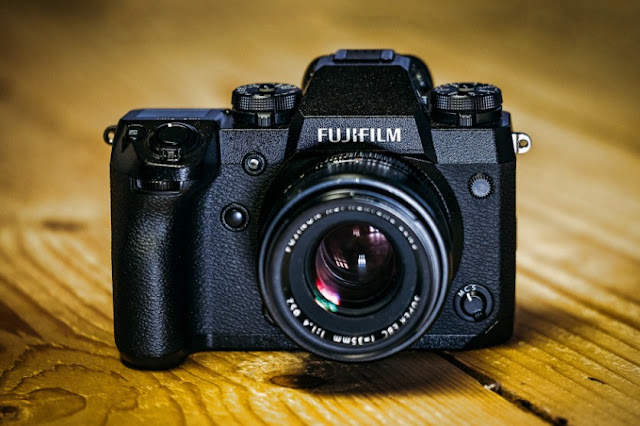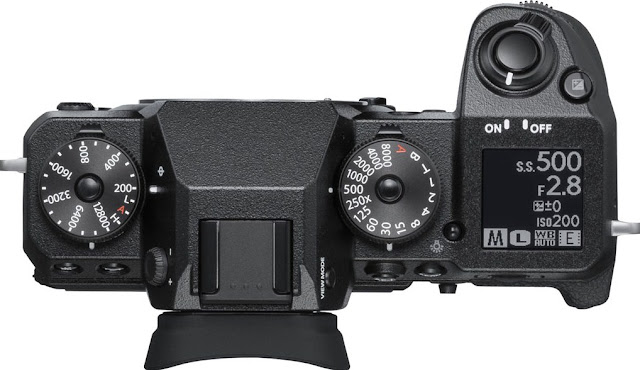We've suggested the Fujifilm X-T2 as our Editors' Choice in the top of the line APS-C mirrorless camera class since it was presented. Presently it has a more premium kin, the X-H1 ($1,899, body just), which utilizes a similar sensor, however includes body adjustment and more genuine video highlights. There are some ergonomic changes, too including a more profound handgrip and the exclusion of an EV control dial. The X-H1 conveys a $300 premium over the X-T2, and is shut in cost to the $1,999 full-outline Sony a7 III, which is similarly as proficient from various perspectives. In any case, on the off chance that you've chosen that the APS-C sensor estimate is a superior fit for you, the X-H1 is the best alternative in its value section, and our Editors' Choice.
Design
The X-H1 doesn't appear to be much unique from the X-T2 at first look. It's done in dark (we'll need to keep a watch out on the off chance that it gets the Graphite Silver exceptional release treatment that Fujifilm has given to other marquee models), and is simply marginally greater all around, with a detectably bigger handgrip. The camera measures 3.8 by 5.5 by 3.4 inches (HWD) and weighs 1.5 pounds. Contrast that and the X-T2, which is 3.6 by 5.2 by 1.9 inches and weighs 1.1 pounds.
The additional weight is because of the camera's inward development. Its magnesium combination case is 25 percent thicker than the X-T2's, and there's broad fixing to shield its internals from clean and dampness. It's appraised to work in extraordinary temperatures too, as low as 14 degrees Fahrenheit. I shot with the X-H1 amid a blanketed nor'easter and it worked fine and dandy.
The bigger size considers a more profound handgrip, a major in addition to in case you're blending the camera with a long focal point like the XF 100-400mm. I like the outline change, yet picture takers with littler hands may feel that the grasp is a bit too profound.
The shade discharge is calculated on the grasp, and has a responsive, spring like feel in real life, another change in ergonomics. The X-T2's screen is level on its best plate, which is fine for its more unobtrusive casing, however to shoot with a major focal point I have a tendency to lean toward a more profound handgrip with a calculated shade discharge.
There are various on-body controls, as you'd anticipate from a genius review camera. On the best plate, to one side of the hot shoe, is a committed control dial. It's a settled plan, with ISO to finish everything and drive control at the base. Drive modes incorporate single, three rates of nonstop shooting, computerized sectioning, a scene setting, and a video mode. The ISO control is helpful, yet I don't care for one part of its outline. It can be balanced from ISO 200 through 12800 in third-stop incremements, and furthermore has an A (programmed) position, which can change the ISO over that same range. There's a L setting, for ISO 100, and a H setting, which should be modified for either ISO 25600 or ISO 51200. The camera is really equipped for creating useable pictures at the two settings (in Raw configuration), and it's a torment to need to plunge into the product to change the H esteem. I'd love to see the A position have the capacity to utilize 25600 and 51200, which would take a straightforward firmware settle.
Only beside the dial, at a point on the EVF bump, is a diopter control for the viewfinder. The hot shoe is focused at the best behind the focal point, and backings outside flashes and embellishments. The shade speed dial is simply to one side of the EVF and is likewise double level; the base alters the metering design. There are four alternatives, Spot, Center Weighted, Multi, and Average. You'll need to utilize Multi for most shots, as it utilizes scene acknowledgment to wisely assess the edge to decide the best presentation settings. Spot and Center Weighted are great decisions for shots with enormously blended lighting, incorporating those with a solid backdrop illumination. I didn't discover much use for the Average setting, however it can enable the camera to better nail presentation for representations of subjects wearing dark or white. Focus on the situation of the metering lever; I found that it was inclined to slipping strange while moving all through a camera sack. It's not as tight as the comparable Drive dial, which didn't move amid our audit.
The monochrome data LCD takes up whatever is left of the space to finish everything. It's illuminated, with a button appropriate alongside it to initiate the light, and shows presentation settings and other data. The previously mentioned screen discharge sits in front of it, alongside a button for EV remuneration control. The show indicates presentation, the dynamic film recreation mode, and other sundry data. It's additionally illuminated, so you can see it when working in diminish conditions, yet none of alternate controls are. We haven't seen illuminated control buttons on a mirrorless camera starting at yet, yet the Nikon D500 SLR, which is an immediate contender to the X-H1 as far as capacity and cost, incorporates them. They're a major in addition to for working in a diminish studio and for astrophotography, control buttons are difficult to utilize if it's excessively dim, making it impossible to peruse them.
The best LCD replaces the X-T2's committed EV pay dial. I'm a fanatic of the dial approach, yet not every person is. I lean toward the speedy, moment control you get from a solitary dial, and additionally the huge visual reference. Some different cameras without a committed EV dial, similar to the Nikon D500, enable you to utilize the back summon dial for devoted EV change. The X-H1 doesn't, you'll have to press the best EV button while turning the back dial to change the setting.
The Delete and Play buttons are on the back, close to the best, to one side of the eyecup. To their privilege are AE-L and AF ON buttons, alongside the back control dial. There's a little concentration joystick for speedy changes of the dynamic concentration point or focuses, just to one side of the back LCD, open utilizing your correct thumb. Beneath it is a four way control cushion, with the Menu/OK button at its inside, and the Display/Back button.
Balancing the physical controls is the Q button. It's situated on the back board, on a knock on the far right side that serves as a thumb rest. It dispatches an on-screen control menu for coordinate change of various different settings, including the film reenactment mode for JPGs, the document organize, commotion diminishment, LCD brilliance, confront discovery, and others. It can be explored utilizing back controls or by means of the touch LCD.
The 3 inch raise show is mounted on an indistinguishable kind of pivot from the X-T2 and has a 1,040k-dab determination. It can tilt all over as should be expected, and has an extra pivot to look toward the right. It's great to have this measure of modification, however I would have jumped at the chance to have seen Fuji utilize a genuine vari-point show, one that can swing out to the side and face the distance forward, for a camera with as hearty video alternatives as the X-H1.
There's additionally an EVF, a given on an ace mirrorless body. It's a 0.5 inch OLED outline with an exceptionally fresh 3.69-million dab determination (an update from the 2.63 million speck discoverer utilized by the X-T2). The amplification is 0.75x, somewhat less than the 0.77x X-T2 discoverer, however the distinction is irrelevant. It revives rapidly, 100 times each second, so you can successfully track quick moving activity.
Highlights, Power, and Connectivity
Fujifilm cameras have since quite a while ago included Film Simulation modes, essentially custom JPG settings that are tuned to imitate film supplies of yesteryear. The X-H1 incorporates every one of the ones we've become used to, running from the quieted shades of Classic Chrome (Fujifilm's interpretation of previous adversary Kodak's Kodachrome) to the serious tones of Velvia and the monochrome tones of Acros, with numerous choices in the middle. For devotees of grain, each film has an adaptable sum, with Low or High settings, or you can decide on no extra grain in the event that you lean toward a cleaner picture.
The X-H1 has another alternative, Eterna, which is designed according to Fujifilm's movie stock. It's somewhat quieted in shading tone, and lifts up the blacks to demonstrate better detail in shadows. It's planned for use in video, yet you can apply the hope to in any case pictures too.
The camera likewise wears an intervalometer work for time-pass photography. Pictures are spared indivudally, instead of in a video record, so you'll need to assemble them utilizing programming if a video is what you're after. You can set interims as short as one moment and as long as 24 hours, for a set number of casings up to 999 or as long as the camera is controlled. It's a component we've generally expected in premium cameras and it regards see it here with the 24MP still determination you can render out time slips at 6K determination.
There's additionally an extra grasp accessible, the Vertical Power Booster Grip ($329), which can be purchased in a package alongside the camera for $2,199, an unassuming investment funds. The grasp completes a couple of things, it holds two extra batteries, expands the greatest video cut length from 15 to 30 minutes, includes a 3.5mm earphone jack, and ups the best shooting rate with the mechanical shade from 8 to 11fps. It is likewise a charger, so you can energize every one of the three batteries on the double.
Including the hold makes the X-H1 a bulkier camera. It adds 1.9 crawls to the tallness and 12.3 ounces of mass. I regularly incline toward a littler camera, shooting with a Nikon D5 or Canon EOS-1D X Mark II with their enormous, incorporated vertical shooting holds isn't my most loved activity. However, the hold is accessible on the off chance that you incline toward a beefier body, or essentially need to broaden the shooting life and lift the X-H1's speed.
The grasp incorporates a flip change to empower Boost shooting, which draws control from different batteries all the while to enhance the speed of the effectively reponsive X-H1. It additionally has a concentration joystick, much the same as the one on the body, double control dials, a screen discharge with encompassing Lock button, and an EV remuneration button. These are all in practically an indistinguishable place from they are on X-H1 body, so you'll for the most part feel as good utilizing it in picture introduction as you do in scene.
Two or three buttons do change size and position. The AE-L and AF-ON buttons are on the grasp, however they're littler than their on-body partners and not as agreeable to press. The Q button has been moved, it's nearer to the screen discharge on the grasp, however I'm somewhat astonished that it's incorporated by any means. The on-screen Q menu doesn't pivot, so you'll be taking a gander at it sideways in the event that you need to modify settings when shooting in representation introduction.
The X-H1 has the typical cluster of remote correspondence tech, both Bluetooth and Wi-Fi. They work with the Fuji Camera Remote application, for Android and iOS, so you can exchange photographs to your cell phone for social sharing.
Physical associations incorporate small scale HDMI, smaller scale USB 3.0, a 3.5mm amplifier jack, a 2.5mm remote control association, and a PC adjust streak terminal. There are double SD card openings, both supporting the most recent arrangements and UHS-II speeds.
The battery charges outside the camera. It's evaluated for 310 shots for each charge, however just 35 minutes of video recording. This is something I observed to restrain in genuine utilize. I was shooting a blend of pictures and video for this audit, and even in shorter photograph strolls I wound up utilizing the Booster Grip to broaden shooting time. The measure of energy utilized by the video recording framework had a major impact. It's a disgrace that Fujifilm didn't figure out how to crush a bigger battery into the body, as Sony did with the a7 III.
Execution and Autofocus
Start-up time, the length between flicking the power change to the On position and catching an in-center picture, is around 0.8-second by and large. That is a strong outcome for a mirrorless camera, particularly when you consider that the in-body adjustment framework needs to prepared itself before shooting. Self-adjust bolts on decently fast, around 0.1-second in brilliant light and in exceptionally diminish conditions. The last makes the X-H1 a solid alternative for occasion photography, as it doesn't lose a stage when shooting in troublesome light. The self-adjust framework is basically the same as you get with the X-T2, yet the low-light concentration figure is enhanced because of better affectability, the X-T2 requires around 0.3-second to secure concentration diminish conditions.
The X-H1 is worked for speed. All alone it can shoot at 14fps with its electronic screen or 8fps with the mechanical central plane shade. Including the Booster Grip ups the mechanical shade button rate to 11fps. The shooting rate fluctuates a bit; the X-H1 fuses gleam diminishment for burst shooting. In case you're working under fluorescent or mercury lights the camera will modify its discharging rate with a specific end goal to keep shine steady from shot to shot. Also, in case you're working in AF-C mode the camera can ease back its rate to guarantee a high level of in-center pictures, you can tune it to organize center exactness or speed. We cleared out it at the default setting, which underscores speed, for testing, and were content with the outcomes.
You can likewise alter how rapidly the camera's concentration framework functions. There are a few presets accessible. A multi-reason choice is the default, however you can change the self-adjust framework to organize subject following while at the same time disregarding snags, to better maintain center around subjects that change speed, for subjects that abruptly fly into the edge, or for subjects that both alter speed and course eratically. Each is represented in the menu with a common utilize case, olympic style sports, nature photography, auto confronting, ski bouncing, and tennis, separately. Furthermore, each can be tweaked, or you can influence your own particular custom setting with flexible subject following affectability, to speed following affectability, and center region exchanging.
Yet in addition remember that you'll get the most responsive concentration execution from the territory of the X-H1 sensor secured with stage identification focuses. Stage location covers the focal third or somewhere in the vicinity, lengthwide, with littler strips at the best and base that aren't secured by the concentration region by any means. The focal square is flanked on the two sides by differentiate focuses, which are viable for locking on to targets, yet not as great when following moving subjects. It's a standout amongst other frameworks you'll find in an APS-C mirrorless camera, yet in the event that still photography is your principle concern and following moving subjects is vital, in other words, on the off chance that you live for games, untamed life, and activity photography you'll get more extensive stage location scope with the APS-C Nikon D500 SLR or the full-outline Sony a7 III mirrorless. Obviously, in the event that you choose a SLR, you'll lose speedy concentration for video, the D500 just has stage identification when utilizing the optical viewfinder to shoot stills. That doesn't imply that the X-H1 center is futile when you move far from the focal point of the edge; it's more than satisfactory for most subjects, however not as speedy to respond to changes at the middle focuses.
In our tests, the X-H1 fell behind its appraised top of the line speed by a small amount of a moment, indenting 13.9fps with the electronic shade, however hit 8fps when utilizing the mechanical one. The electronic shade has the benefit of being quiet, however can present movement contortion in pictures when shooting quick moving subjects. The mechanical screen is peaceful, likely an aftereffect of the camera's broad climate fixing, so despite the fact that it fires rapidly, it doesn't add a great deal of clamor to the earth.
Including the supporter ups the mechanical screen speed to 11fps; we really observed better numbers, around 11.7fps, in our speed tests. You should set aside the opportunity to jump into the camera menu to empower this even with the grasp appended and set to its Boost mode, the default top speed remains at 8fps.
Yet, to what extent would you be able to keep up a lively pace? It relies upon the document arrange you utilize, the X-H1 shoots uncompressed Raw, packed Raw, and JPG pictures and the speed of your memory card. We tried the X-H1 with a Sony SDXC card evaluated for 299MBps compose speed. When shooting at 8fps the camera oversees 26 uncompressed Raw+JPG, 29 compacted Raw+JPG, 28 uncompressed Raw, or 42 packed Raw before backing off. Cushion clear circumstances are around 9 seconds for Raw+JPG and 7 seconds for Raw. You can continue shooting JPGs at 8fps for whatever length of time that you need when utilizing a quick memory card.
Changing to 14fps decreases the measure of pictures you can button at once. For a wide range of Raw photography you get around 21 shots before it backs off, and only 32 JPGs. The outcomes at 11fps are, typically, some place in the middle. Expect around 22 Raw+JPG shots and 67 JPGs before the camera backs off, with comparative circumstances to clear the cushion for Raw photography and around 3.3 seconds required to compose all JPGs to the card.
Shooting quick is essential, yet it doesn't mean anything if your pictures are out of core interest. The X-H1 does well on our standard AF-C test, in which the camera photos an objective that pushes toward and far from the focal point. Ceaseless concentration is slower, however very exact, with most by far of shots freshly in center. Expect 9.3fps with the electronic shade, 7.7fps without the Booster, and 9.7fps with the hold in Boost mode.
The self-adjust framework is like the astounding one from the X-T2, however changes have enhanced its execution. One of those is the capacity to center with focal points with a diminish f/11 most extreme opening, the X-T2 was appraised for f/8. While you won't discover any available that nearby down to f/11 all alone, including a teleconverter cuts the viable f-stop. The X-H1 works with the 100-400mmpaired with a 2x teleconverter, the likeness a 1200mm f/11 full-outline focal point when zoomed the distance in. I utilized the mix a considerable amount in the field and was content with the concentration comes about. Indeed, even in burst mode the X-H1 viably obtained center and followed moving subjects. I'd love to see Fujifilm discharge something like a 400mm f/4 to better match with a teleconverter later on, however for the present moment, picture takers who use outrageous fax points in their work will acknowledge what the framework brings to the table.
Picture Quality
The picture sensor is a 24.3MP X-Trans CMOS III outline in the same APS-C estimate that Fujifilm utilizes for the X mirrorless framework. It's a similar sensor we've found in late Fujifilm cameras, including the X-T2 and X-Pro2, yet the X-H1 includes body adjustment. Fujifilm rates its adequacy to up to 5.5 quits, contingent upon which focal point you combine it with.
I tried the adjustment framework with the XF 50mm F2, a direct zooming focal point without its own particular adjustment framework. When sitting I got reliably sharp outcomes at 1/15-second, only a two-stop advantage. At 1/8-second, which requires three stops of pay, about a large portion of my test shots were fresh and half were marginally obscured. At 1/4-second things were reliably hazy. Results with the XF 23mm F2 were comparative, fresh pictures at 1/15-second, with obscure sneaking in at 1/8-second.
Focal points with worked in adjustment use both their own particular frameworks and the sensor to enduring shots. The XF 80mm Macro additionally clung to the 1/15-second control, albeit one of my five test pictures at 1/4-second was tack sharp. A more drawn out focal point, the XF 100-400mm set to the 200mm position, began indicating obscure somewhat before, at 1/30-second.
So take the 5.5-quit rating with a grain of salt. The adjustment is compelling, yet not to the level that Fujifilm claims in view of our tests. I found it to be considerably more powerful for video. Handheld film with the XF 23mm hinted at no jitter. Furthermore, while I wasn't hoping to get anything useable from it, handheld film with the 100-400mm at 400mm with a 2x teleconverter joined really got some average outcomes, as should be obvious in one clasp from our test film underneath. (I suggest utilizing that mix with a tripod for any kind of genuine work, notwithstanding.)
With respect to picture quality, I tried the standard JPG yield utilizing Imatest. It demonstrates that the X-H1 holds commotion under 1.5 percent through ISO 6400. We've seen cameras that set up preferable numbers over that, yet they commonly utilize agressive clamor diminishment to arrive. Fujifilm adopts a lighter strategy. You can shoot through ISO 1600 with no unmistakable loss of picture quality. Be that as it may, you're ready to push the camera to ISO 12800 and see just a slight obscuring of detail. There's somewhat more obscure at ISO 25600, yet picture JPG quality is as yet solid. It's not until the point that you get to the best ISO 51200 setting that subtle elements are washed away.
Shooting in Raw nets crisper, however grainier, comes about at high ISOs. Subtle elements are solid, without overpowering clamor, through ISO 12800. You can even now observe scarce differences at ISO 25600, however grain gives photographs an observably harsh surface. At ISO 51200 there's no obscuring at all, yet there is an overwhelming, unpleasant grain, which wipes away fine points of interest. As we've seen with other Fujifilm cameras that utilization this picture sensor, this is among as well as can be expected as of now get in the APS-C organize.
Video
Fujifilm's cameras have not been a best decision for video generation previously. An absence of in-body adjustment and a stills-first disposition, combined with moderate selection of 4K, have pushed videographers to mirrorless models from Olympus, Panasonic, and Sony. The organization plans to change that with the X-H1. Not exclusively is it the primary body we've seen from Fuji with in-body adjustment, the organization is likewise reporting two silver screen zoom focal points, the MKX 18-55mm T2.9 and 50-135mm T2.9, both with outfitted concentration, zoom, and opening rings, smothered concentration breathing, and support for Hollywood-level extras, including matte boxes.
The camera itself can shoot at 4K quality, in both DCI and UHD groups. It bolsters 23.98 and 24fps at DCI (4,096 by 2,160) and your decision of 23.98, 24, 25, and 29.97fps when working in UHD (3,840 by 2,160). You can likewise shoot at 1080p or 720p at all of those edge rates, in addition to 50 and 59.94fps. There's additionally in-camera moderate movement at 1080p 120fps.
Video recording is constrained to 15 minutes for each clasp, however including the Booster Grip stretches out the clasp length to 30 minutes. The grasp likewise has a 3.5mm earphone jack, which is absent from the body and an absolute necessity have for observing sound on set or in the field.
There are various shading profiles accessible, Fuji calls some of them Film Simulation modes, so you can record film with a similar Classic Chrome, Acros, Provia, or Velvia looks you can use for JPG pictures. The X-H1 has another film mode, Eterna, that impersonates the look of silver screen film. You likewise shoot with a level profile, F-log, which brings differentiate down to convey 12 stops of dynamic range, giving you flexibility to review film to your loving.
I adhered to Eterna when recording video with the X-H1, appropriately evaluating log film is outside my customary range of familiarity, and Eterna is the thing that Fujifilm is pushing for silver screen ventures where out-of-the-container shading is wanted. To my eye, the recording looks awesome, with fresh detail and wonderful hues. The 200Mbps piece rate surely becomes an integral factor here, regardless of whether it brings about gigantic record sizes.
I was additionally upbeat to perceive how well the self-adjust performs when recording video. Indeed, even with an extraordinary focal point like the 100-400mm, the X-H1 can track subjects as they push toward or far from the edge, with just intermittent chasing for center. The primary clasp in our reel was shot handheld with that mix, combined with a teleconverter, at a ludicrous 1,200mm proportionate edge of view, and keeping in mind that there's judder when panning to take after a subject, the handheld film is very smooth when you think about the focal point.
You'll likewise observe the periodic shake in tripod-mounted shots. However, that is on account of the camera and tripod were themselves on a precarious stage, gliding footpaths along a wetland nature trail, and for our daytime shoreline scenes wind was sufficiently solid to jar my tripod. Sound is recorded in the field, with the X-H1's inward mouthpiece, and you can positively hear the breeze blow in those shots.
There are different cases of handheld film in our test reel. The snow scene and the dribbling icicle were both shot sans tripod with the XF 80mm Macro. Furthermore, you can see some can see a few cases of skew, caused by the moving screen impact, in scenes of trucks going by on the parkway. It's not extraordinary, but rather it's recognizable. Generally, the X-H1 is the best camcorder that Fujifilm has made to date, however in the event that you are about video, a more specific mirrorless camera like the Panasonic GH5S or Sony a7S II is likely a superior fit.
With respect to video controls, there are two or three approaches. Keeping in mind the end goal to shoot video you have to change the Drive dial to the video setting, a takeoff from the Record button you get with most cameras, however average ergonomics for Fuji. Out of the crate, the X-H1 will utilize similar settings you use for stills when changing to video. That is not perfect, as you regularly need an alternate screen speed for recording video than you improve the situation catching still pictures.
You can change to an on-screen control mode, Movie Silent Control. It's available by jumping into the camera menu. When you turn it on, it sticks, you have to backpedal into the menu to turn it off. The interface bolsters touch input, so you can make acclimations to the gap, shade speed, ISO, and different settings without clicking dials or adding undesirable sound to your recording. However, exploring through touch is somewhat cumbersome. You're in an ideal situation utilizing the back concentration joystick to look through the menu and change settings. You simply need to make sure to utilize the left and right directional presses to explore all through settings while changing a few parameters. On the off chance that you hit OK rather, which is the regular nature when making a menu choice, the overlay menu vanishes and you'll have to tap the screen to bring the overlay menu move down.
The best part about utilizing Silent Control is that its settings are isolated from still photography. I can leave my shade dial set at 1/1,000-second to image and have a set 1/48-second screen speed for 24fps video button. In the event that you select not to utilize it, you'll need to make sure to change screen speed physically as you move between still picture and video button. Furthermore, you won't have simple access to the shade speeds utilized for film creation.
Conclusions
The Fujifilm X-H1 conveys a similar class-driving picture quality as the X-T2, yet betters its concentration framework, offering more grounded peformance in diminish light and when shooting video. You likewise get Fujifilm's superb Film Simulation modes for shooting in JPG, and Raw help for picture takers who like to process their own photographs. And keeping in mind that we didn't observe the in-body adjustment to be as compelling for stills as Fujifilm guarantees, shooting fresh handheld pictures at 1/15-second with longer focal points is nothing to sniffle at, and the framework is extremely powerful for video utilize. It adds adaptability to some great Fujinon focal points that overlook in-focal point adjustment, similar to the organization's XF 16-55mm F2.8 expert standard zoom (which was not accessible for me to use at the season of this survey), and betters what in-focal point adjustment can convey alone for focal points that incorporate the element.
The more profound handgrip is welcome, particularly when utilizing bigger focal points like the XF 100-400mm and 80mm Macro, yet the camera still adjusts well with littler, lighter focal points. Picture takers who adore the Fujifilm method for doing things will be upbeat about the ISO and shade speed dials, however may miss the EV dial. As much as I prefer a best data show, I'd want to lose it for faster EV alteration.
The X-H1 faces some solid rivalry as you close to the $2,000 value point. Miniaturized scale Four Thirds cameras from Olympus and Panasonic, the E-M1 Mark II and G9 particularly, have littler sensors yet additionally shoot very quick and offer solid self-adjust and 4K video. Sony has its a6500, which is a bit too little for my taste, but on the other hand is very skilled. These contenders incorporate into body adjustment.
Read other : Canon EOS Rebel SL2
Also, on the SLR front there's the Nikon D500, which needs IBIS, and isn't so proficient with regards to video (it shoots in 4K, however doesn't self-adjust well when recording moving pictures), a run of the mill worry with SLRs. Standard has its 7D Mark II, which centers and tracks subjects well, however is getting more established each day, it appears to be expected for a refresh.
In any case, the obvious issue at hand isn't another APS-C or Micro Four Thirds demonstrate. It's the Sony a7 III, which wears a full-outline sensor, a concentration framework that spreads the majority of the picture outline with stage location, and is equipped for shooting at 10fps without the requirement for an extra hold. It's likewise a 24MP camera, and keeping in mind that we haven't performed lab tests on it yet, we anticipate that it will improve the situation at high ISOs because of its lower pixel thickness and BSI sensor plan. Furthermore, similar to the X-H1, it records video at 4K quality and incorporates into body adjustment. On the off chance that your needs aren't particularly designed for APS-C photography it's a convincing option. The drawback is that its focal points are somewhat bigger and tend to cost more than those for the X framework. Then again, representation picture takers will value the shallower profundity of field that you can get with a full-outline sensor. A 85mm f/1.4 will at present obscure out a foundation more than the nearest comparable focal point for the Fuji framework, the 56mm f/1.2.
Yet, there are positively motivations to stay with APS-C, with littler, more reasonable focal points and the more prominent powerful fax reach offered by the sensor design boss among them. Furthermore, in the littler than-full-outline sensor organize, the X-H1 is the best all-around camera I've seen. It may not be the best at following subjects that goes to the Nikon D500, however it's still exceptionally skilled. It might not have a similar video cleaves as the Panasonic GH5 and GH5S, yet it betters them in self-adjust and conveys solid 4K film in its own right. It may not be as little and light as the Sony a6500, yet its body configuration loans itself better to use with the bigger focal points. The X-H1 does everything these contending cameras do best with nearly as much insight, conveying a great deal of adaptability for your dollar.
It's not the ideal body for everybody, I particularly miss the EV dial yet while it has a few weaknesses all over, its adaptability more than compensates for them. The X-H1 is a hard offer for picture takers who effectively possess a X-T2, unless in-body adjustment is a flat out must-have. However, in the event that you're thinking about an update from a more passage level model, or are as yet utilizing the 16MP X-T1, it's the undeniable pick, and our Editors' Choice among premium, trim sensor mirrorless cameras.
Read other : Lenovo IdeaPad Miix 720













Thank you for visiting. Please leave a comment or request the computer or laptop you want to review. ConversionConversion EmoticonEmoticon